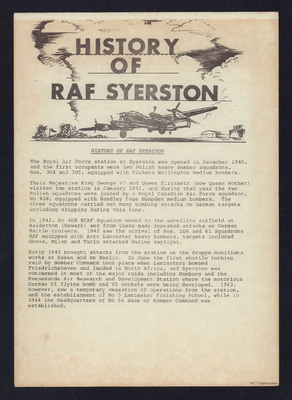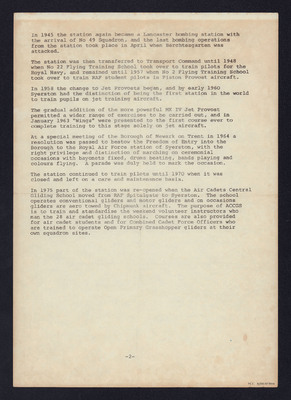History of RAF Syerston
Title
History of RAF Syerston
Description
History of the station from December 1940 including resident squadrons and aircraft , royal visit and other points of interest after the war up to the current day.
Spatial Coverage
Coverage
Language
Type
Format
Two page typewritten document
Publisher
Rights
This content is available under a CC BY-NC 4.0 International license (Creative Commons Attribution-NonCommercial 4.0). It has been published ‘as is’ and may contain inaccuracies or culturally inappropriate references that do not necessarily reflect the official policy or position of the University of Lincoln or the International Bomber Command Centre. For more information, visit https://creativecommons.org/licenses/by-nc/4.0/ and https://ibccdigitalarchive.lincoln.ac.uk/omeka/legal.
Contributor
Identifier
SPerryWRP1317696v60005
Transcription
HISTORY OF RAF SYERSTON
[picture]
[underlined] HISTORY OF RAF SYERSTON [/underlined]
The Royal Air Force station at Syerston was opened in December 1940, and the first occupants were two Polish heavy bomber squadrons, Nos. 304 and 305, equipped with Vickers Wellington medium bombers.
Their Majesties King George VI and Queen Elizabeth (now Queen Mother) visited the station in January 1941, and during that year the two Polish squadrons were joined by a Royal Canadian Air Force squadron, No 408, equipped with Handley Page Hampden medium bombers. The three squadrons carried out many bombing attacks on German targets including shipping during this time.
In 1942, No 408 RCAF Squadron moved to the satellite airfield at Balderton (Newark) and from there made repeated attacks on German Battle cruisers. 1942 saw the arrival of Nos. 106 and 61 Squadrons RAF equipped with Avro Lancaster heavy bombers, targets included Genoa, Milan and Turin attacked during daylight.
Early 1943 brought attacks from the station on the Krupps munitions works at Essen and on Berlin. In June the first shuttle bombing raid by Bomber Command took place when Lancasters bombed Friedrichshaven and landed in North Africa, and Syerston was concerned in most of the major raids including Hamburg and the Peenemunde Air Research and Development Station where the notorious German VI flying bomb and V2 rockets were being developed. 1943, however, saw a temporary cessation of operations from the station, and the establishment of No 5 Lancaster Finishing School, while in 1944 the Headquarters of No 56 Base of Bomber Command was established.
[page break]
In 1945 the station again became a Lancaster bombing station with the arrival of No 49 Squadron, and the last bombing operations from the station took place in April when Berchtesgarten was attacked.
The station was then transferred to Transport Command until 1948 when No 22 Flying Training School took over to train pilots for the Royal Navy, and remained until 1957 when No 2 Flying Training School took over to train RAF student pilots in Piston Provost aircraft.
In 1958 the change to Jet Provosts began, and by early 1960 Syerston had the distinction of being the first station in the world to train pupils on jet training aircraft.
The gradual addition of the more powerful MK IV Jet Provost permitted a wider range of exercises to be carried out, and in January 1963 “Wings” were presented to the first course ever to complete training to this stage solely on jet aircraft.
At a special meeting of the Borough of Newark on Trent in 1964 a resolution was passed to bestow the Freedom of Entry into the Borough to the Royal Air Force station of Syerston, with the right privilege and distinction of marching on ceremonial occasions with bayonets fixed, drums beating, bands playing and colours flying. A parade was duly held to mark the occasion.
The station continued to train pilots until 1970 when it was closed and left on a care and maintenance basis.
In 1975 part of the station was re-opened when the Air Cadets Central Gliding School moved from RAF Spitalgate to Syerston. The school operates conventional gliders and motor gliders and on occasions gliders are aero towed by Chipmunk aircraft. The purpose of ACCGS is to train and standardise the weekend volunteer instructors who man the 28 air cadet gliding schools. Courses are also provided for air cadet students and for Combined Cadet Force Officers who are trained to operate Open Primary Grasshopper gliders at their own squadron sites.
– 2 –
[picture]
[underlined] HISTORY OF RAF SYERSTON [/underlined]
The Royal Air Force station at Syerston was opened in December 1940, and the first occupants were two Polish heavy bomber squadrons, Nos. 304 and 305, equipped with Vickers Wellington medium bombers.
Their Majesties King George VI and Queen Elizabeth (now Queen Mother) visited the station in January 1941, and during that year the two Polish squadrons were joined by a Royal Canadian Air Force squadron, No 408, equipped with Handley Page Hampden medium bombers. The three squadrons carried out many bombing attacks on German targets including shipping during this time.
In 1942, No 408 RCAF Squadron moved to the satellite airfield at Balderton (Newark) and from there made repeated attacks on German Battle cruisers. 1942 saw the arrival of Nos. 106 and 61 Squadrons RAF equipped with Avro Lancaster heavy bombers, targets included Genoa, Milan and Turin attacked during daylight.
Early 1943 brought attacks from the station on the Krupps munitions works at Essen and on Berlin. In June the first shuttle bombing raid by Bomber Command took place when Lancasters bombed Friedrichshaven and landed in North Africa, and Syerston was concerned in most of the major raids including Hamburg and the Peenemunde Air Research and Development Station where the notorious German VI flying bomb and V2 rockets were being developed. 1943, however, saw a temporary cessation of operations from the station, and the establishment of No 5 Lancaster Finishing School, while in 1944 the Headquarters of No 56 Base of Bomber Command was established.
[page break]
In 1945 the station again became a Lancaster bombing station with the arrival of No 49 Squadron, and the last bombing operations from the station took place in April when Berchtesgarten was attacked.
The station was then transferred to Transport Command until 1948 when No 22 Flying Training School took over to train pilots for the Royal Navy, and remained until 1957 when No 2 Flying Training School took over to train RAF student pilots in Piston Provost aircraft.
In 1958 the change to Jet Provosts began, and by early 1960 Syerston had the distinction of being the first station in the world to train pupils on jet training aircraft.
The gradual addition of the more powerful MK IV Jet Provost permitted a wider range of exercises to be carried out, and in January 1963 “Wings” were presented to the first course ever to complete training to this stage solely on jet aircraft.
At a special meeting of the Borough of Newark on Trent in 1964 a resolution was passed to bestow the Freedom of Entry into the Borough to the Royal Air Force station of Syerston, with the right privilege and distinction of marching on ceremonial occasions with bayonets fixed, drums beating, bands playing and colours flying. A parade was duly held to mark the occasion.
The station continued to train pilots until 1970 when it was closed and left on a care and maintenance basis.
In 1975 part of the station was re-opened when the Air Cadets Central Gliding School moved from RAF Spitalgate to Syerston. The school operates conventional gliders and motor gliders and on occasions gliders are aero towed by Chipmunk aircraft. The purpose of ACCGS is to train and standardise the weekend volunteer instructors who man the 28 air cadet gliding schools. Courses are also provided for air cadet students and for Combined Cadet Force Officers who are trained to operate Open Primary Grasshopper gliders at their own squadron sites.
– 2 –
Collection
Citation
“History of RAF Syerston,” IBCC Digital Archive, accessed July 22, 2024, https://ibccdigitalarchive.lincoln.ac.uk/omeka/collections/document/36249.
Item Relations
This item has no relations.


